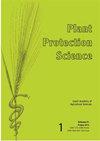竹叶提取物对菜花大蠹的化学特征及抑菌活性研究
IF 1.7
4区 农林科学
Q2 AGRONOMY
引用次数: 1
摘要
phaseolina是一种非常有问题的真菌,它会导致数百种植物的疾病。为了寻找化学杀菌剂的替代品来防治这一毁灭性的病原菌,本研究对大黄叶提取物的防治效果进行了评价。5种浓度的甲醇叶提取物分别为1、2、3、4和5% (w/v),对菜叶分枝杆菌进行了检测。这些浓度均显著抑制了菜绿支原体的生长,使菜绿支原体生物量较对照减少34 ~ 74%。GC-MS分析表明该提取物含有54种化合物。角鲨烯为优势化合物,峰面积为24.11%,其次为维生素E,峰面积为8.96%。其他重要的化合物有:十六烷酸、2-羟基-1-(羟甲基)乙酯(6.21%)、噻吩、四氢-2-甲基(5.68%)、环戊醇(5.61%)、新植物二烯(6.25%)、1-叔丁基丙烷-2-基2-甲基丁酸酯(6.03%)、伊博gamine-18-羧酸、12-甲氧基-甲酯(2.95%)、叶绿醇(2.26%)和正十六烷酸(2.20%)。其中一些主要化合物可能是导致金针叶甲醇提取物对菜绿霉具有抗真菌作用的原因。本文章由计算机程序翻译,如有差异,请以英文原文为准。
Chemical Profile and Antifungal Activity of Leaf Extract of Tabernaemontana divaricata against Macrophomina phaseolina
Macrophomina phaseolina is a highly problematic fungus that causes diseases in hundreds of plant species. In order to search for an alternative to chemical fungicides for the control of this devastating pathogen, leaf extract of Tabernaemontana divaricata was assessed for the control of M. phaseolina. Five concentrations of leaf extract in methanol viz. 1, 2, 3, 4 and 5% (w/v), were checked against M. phaseolina. All these concentrations significantly suppressed the fungal growth resulting in 34–74% decreased biomass of M. phaseolina over control. GC-MS analysis of this extract showed the presence of 54 compounds. Squalene was the predominant compound with 24.11% peak area followed by vitamin E (8.96%). Other important compounds were hexadecanoic acid, 2-hydroxy-1-(hydroxymethyl)ethyl ester (6.21%), thiophene, tetrahydro-2-methyl- (5.68%), cyclopentanol (5.61%), neophytadiene (6.25%), 1-tert-butoxypropan-2-yl 2-methylbutanoate (6.03%), ibogamine-18-carboxylic acid, 12-methoxy-, methyl ester (2.95%), phytol (2.26%), and n-hexadecanoic acid (2.20%). Some of these major compounds might be responsible for antifungal property of methanolic leaf extract of T. divaricata against M. phaseolina.
求助全文
通过发布文献求助,成功后即可免费获取论文全文。
去求助
来源期刊

Plant protection science
Agronomy-PLANT SCIENCES
CiteScore
2.90
自引率
7.70%
发文量
30
审稿时长
12 weeks
期刊介绍:
Original papers, short communications, critical reviews, personal news, and book reviews covering all areas of diseases and pests of plants, weeds and plant protection. Papers are published in English.
 求助内容:
求助内容: 应助结果提醒方式:
应助结果提醒方式:


